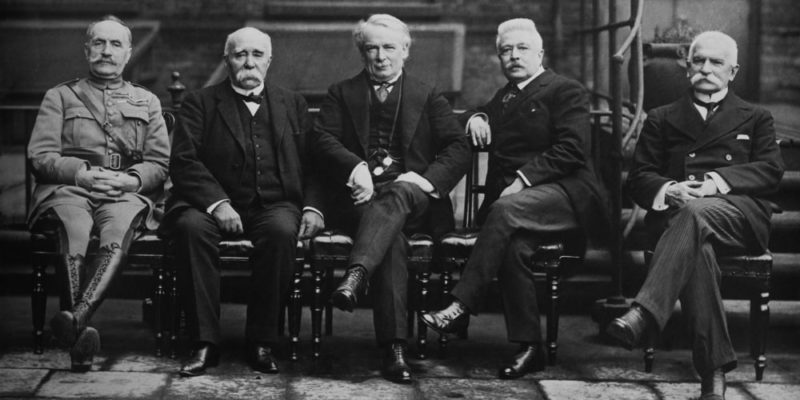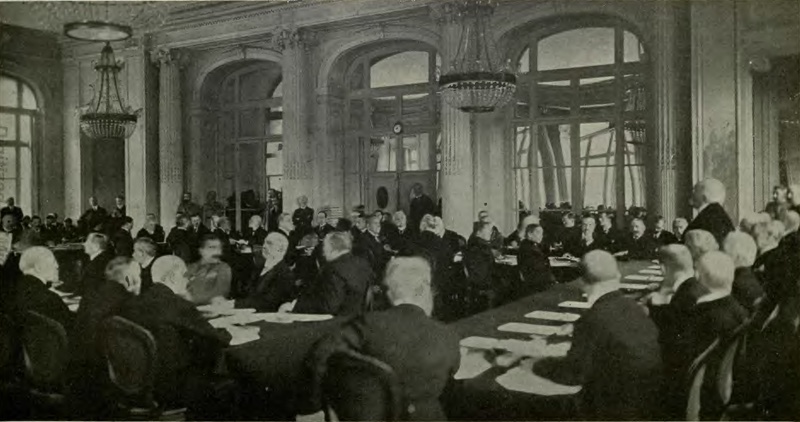We explain what the Treaty of Versailles was, the conditions it imposed on Germany, its causes and consequences.

What was the Treaty of Versailles of 1919?
The Treaty of Versailles was an agreement signed in 1919 between the main victors of the First World War (1914-1918) and Germany, which had been defeated. The treaty was signed in the Hall of Mirrors of the City Palace of Versailles, France.
The Treaty of Versailles established that Germany had been responsible for the development of the First World War and, therefore, serious conditions were imposed on him. Among them, mandatory disarmament, the payment of war reparations (monetary compensation) and the loss of large portions of territory.
The terms of the treaty generated enormous resentment in the German population and the feeling that the debt would be impossible to pay. Many specialists consider that the effects of the Treaty of Versailles generated the social, political and economic conditions necessary for the rise of Nazism in Germany and Adolf Hitler's accession to power.
At the end of the First World War, the German Empire disintegrated and the Weimar Republic was established in Germany. However, this regime was marked by political, economic and social instability, which was worsened by the harsh living conditions that German society was experiencing.
In this context, the Treaty of Versailles was highly criticized by the Germans and even other nations. The United States (one of the victorious powers of World War I) refused to sign the agreement because it maintained that such harsh conditions would have worse consequences. Throughout the following decade, the impositions of the agreement lost force.
What did the Treaty of Versailles establish?

The Treaty of Versailles was made up of fifteen parts, each made up of a variable number of articles, in which the different resolutions were detailed. These ranged from economic and financial sanctions to the redefinition of Germany's borders and the commitment to avoid armed conflict.
Among the main resolutions, the Treaty of Versailles established:
- That the German Empire was disintegrated and therefore Germany and Austria were to remain separate States.
- That Germany recognized itself as primarily responsible for the First World War and, therefore, had to respond for the damage and destruction caused. In addition, he was prohibited from entering the League of Nations (a newly created international organization.
- That Germany lost the territories of Alsace and Lorraine (at the hands of France), Eupen and Malmedy (Belgium), Posnania and southern Upper Silesia (Poland), Danzig and Memel (free), northern Schleswig-Holstein (Denmark). In total, this meant 13% of its territory, in which almost 10% of its population lived. In addition, it lost all its colonies and the Saar basin.
- That Germany should begin a disarmament process that is, the limitation of its Navy and its Army. In addition, the total demilitarization of the Rhineland (border region with France) and its partial occupation by allied troops was established.
- That Germany had to pay war reparations to the winning countries. In the following conferences, the total amount (132 billion gold marks) and its distribution (52% for France, 22% for the United Kingdom, 10% for Italy, 8% for Belgium and 8% for other countries) were established.
Other clauses that were added later in the Treaty of Versailles stated:
- That Germany deliver all German war material to the Allies along with its war fleet, and the reduction of its army to 100,000 men and 4,000 officers, without heavy artillery, submarines, or aviation. In addition, the Germans were prohibited from manufacturing war material and the Army General Staff was dissolved. Compulsory military service was also abolished.
- Let Germany hand over the entire German merchant fleet to the Allies: The annual transfer of 200,000 tons of new ships was agreed to, to replace those destroyed in the allied countries. It was also agreed to hand over enormous amounts of material resources, such as coal, cattle and all types of German private property in colonial territory. In addition, Germany would deliver to the Allies half of its pharmaceutical and chemical production and all of its submarine cable production, over a period of five years.
Causes of the Treaty of Versailles

The Treaty of Versailles was the product of peace negotiations that took place at the Paris Conference in 1919. Only representatives of the victorious nations attended this meeting. Among the most important leaders were: David Lloyd George (United Kingdom), Woodrow Wilson (United States), Georges Clemenceau (France) and Vittorio Emanuele Orlando (Italy).
The negotiations took into account previous treaties that were signed during the First World War between the different nations. Each country had divergent interests and the conference served as a space for debate to decide what conditions to impose on the defeated countries.
All victorious countries considered that Germany should pay them war reparations. On the other hand, They differed over the level of punishment that needed to be imposed on the Germans. Clemenceau, representing France, was the one who had a more radical position while the representative of Italy only aspired to obtain territorial compensation.
Finally, The French position of treating Germany more harshly ended up winning. However, the United States criticized this position and, months later, refused to sign the Treaty of Versailles.
Consequences of the Treaty of Versailles

The terms of the treaty were received by the German population with great regret. Many considered it an insult and humiliation. Its economic consequences in Germany were devastating: they unleashed hyperinflation, increased social unrest and deepened political instability.
In this context, the riots in the streets led to the radicalization of political movements. In the following decade, Nazism grew enormously and one of its main banners was the denial of the resolutions established by the Treaty of Versailles.
References
- Britannica, Encyclopaedia (2022). Treaty of Versailles. Encyclopedia Britannica. https://www.britannica.com/
- Cabrera, M., Juliá, S. & Martín Aceña, P. (comps.) (1991). Europe in crisis. 1919-1939. Pablo Iglesias Editorial.
- Sevillano Calero, F. (2020). Europe between the wars. The disrupted order. Synthesis.





